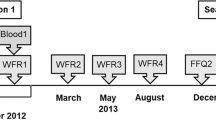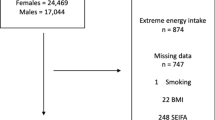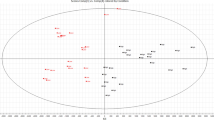Abstract
Background/Objectives:
The diversity of the chemical structures of dietary polyphenols makes it difficult to estimate their total content in foods, and also to understand the role of polyphenols in health and the prevention of diseases. Global redox colorimetric assays have commonly been used to estimate the total polyphenol content in foods. However, these assays lack specificity. Contents of individual polyphenols have been determined by chromatography. These data, scattered in several hundred publications, have been compiled in the Phenol-Explorer database. The aim of this paper is to identify the 100 richest dietary sources of polyphenols using this database.
Subjects/Methods:
Advanced queries in the Phenol-Explorer database (www.phenol-explorer.eu) allowed retrieval of information on the content of 502 polyphenol glycosides, esters and aglycones in 452 foods. Total polyphenol content was calculated as the sum of the contents of all individual polyphenols. These content values were compared with the content of antioxidants estimated using the Folin assay method in the same foods. These values were also extracted from the same database. Amounts per serving were calculated using common serving sizes.
Results:
A list of the 100 richest dietary sources of polyphenols was produced, with contents varying from 15 000 mg per 100 g in cloves to 10 mg per 100 ml in rosé wine. The richest sources were various spices and dried herbs, cocoa products, some darkly coloured berries, some seeds (flaxseed) and nuts (chestnut, hazelnut) and some vegetables, including olive and globe artichoke heads. A list of the 89 foods and beverages providing more than 1 mg of total polyphenols per serving was established. A comparison of total polyphenol contents with antioxidant contents, as determined by the Folin assay, also showed that Folin values systematically exceed the total polyphenol content values.
Conclusions:
The comprehensive Phenol-Explorer data were used for the first time to identify the richest dietary sources of polyphenols and the foods contributing most significantly to polyphenol intake as inferred from their content per serving.
This is a preview of subscription content, access via your institution
Access options
Subscribe to this journal
Receive 12 print issues and online access
$259.00 per year
only $21.58 per issue
Buy this article
- Purchase on Springer Link
- Instant access to full article PDF
Prices may be subject to local taxes which are calculated during checkout

Similar content being viewed by others
References
Bognar A (2002). Tables on weight yield of food and retention factors of food constituents for the calculation of nutrient composition of cooked foods (dishes). Berichte der Bundesforschungsanstalt für Ernährung. Karlsruhe. http://www.eurofir.org/?q=node/9, accessed on 5 July 2009.
Brat P, Georgé S, Bellamy A, Du Chaffaut L, Mennen L, Arnault N et al. (2006). Daily polyphenol intake in France from fruit and vegetables. J Nutr 136, 2368–2373.
Cassidy A, Hanley B, Lamuela-Raventos RM (2000). Isoflavones, lignans and stilbenes—origins, metabolism and potential importance to human health. J Sci Food Agr 80, 1044–1062.
Food Standards Agency (2002). Food Portion Sizes. H M Stationery Office: London.
Kühnau J (1976). The flavonoids: a class of semi-essential food components: their role in human nutrition. World Rev Nutr Diet 24, 117–191.
Loke WM, Proudfoot JM, Stewart S, McKinley AJ, Needs PW, Kroon PA et al. (2008). Metabolic transformation has a profound effect on anti-inflammatory activity of flavonoids such as quercetin: lack of association between antioxidant and lipoxygenase inhibitory activity. Biochem Pharmacol 75, 1045–1053.
Manach C, Williamson G, Morand C, Scalbert A, Remesy C (2005). Bioavailability and bioefficacy of polyphenols in humans. I. Review of 97 bioavailability studies. Am J Clin Nutr 81, 230S–242S.
Mink PJ, Scrafford CG, Barraj LM, Harnack L, Hong CP, Nettleton JA et al. (2007). Flavonoid intake and cardiovascular disease mortality: a prospective study in postmenopausal women. Am J Clin Nutr 85, 895–909.
Neveu V, Pérez-Jiménez J, Vos F, Crespy V, Du Chaffaut L, Mennen L et al. (2010). Phenol-Explorer: an online comprehensive database on polyphenol contents in foods. Databases 2010, bap024.
Ovaskainen ML, Torronen R, Koponen JM, Sinkko H, Hellstrom J, Reinivuo H et al. (2008). Dietary intake and major food sources of polyphenols in Finnish adults. J Nutr 138, 562–566.
Pérez-Jiménez J, Neveu V, Vos F, Scalbert A (2010). A systematic analysis of the content of 502 polyphenols in 452 foods and beverages—An application of the Phenol-Explorer database. J Agric Food Chem 58, 4959–4969.
Scalbert A (1992). Quantitative methods for the estimation of tannins in plant tissues. In: Hemingway RW, Laks PE (eds). Plant Polyphenols, Synthesis, Properties, Significance. Plenum Press: New York, pp 259–280.
Scalbert A, Manach C, Morand C, Remesy C, Jimenez L (2005). Dietary polyphenols and the prevention of diseases. Crit Rev Food Sci Nutr 45, 287–306.
Singleton VL, Rossi JA (1965). Colorimetry of total phenolics with phosphomolybdic-phosphotungstic acid reagents. Am J Enol Viticult 16, 144–158.
USDA (United States Department of Agriculture) (2004). Nutrient Data Laboratory. USDA Database for the Proanthocyanidin Content of Selected Foods. Available from http://www.ars.usda.gov/nutrientdata.
USDA (United States Department of Agriculture) (2007). Nutrient Data Laboratory. USDA Database for the Flavonoid Content of Selected Foods—Release 2.1. Available from http://www.ars.usda.gov/nutrientdata.
USDA (United States Department of Agriculture) (2008). Nutrient Data Laboratory. USDA Database for the Isoflavone Content of Selected Foods—Release 2.0. Available from http://www.ars.usda.gov/nutrientdata.
Velioglu YS, Mazza G, Gao L, Oomah BD (1998). Antioxidant activity and total phenolics in selected fruits, vegetables, and grain products. J Agric Food Chem 46, 4113–4117.
Vinson JA, Hao Y, Su X, Zubik L (1998). Phenol antioxidant quantity and quality in foods: vegetables. J Agric Food Chem 46, 3630–3634.
Vinson JA, Mandarano M, Hirst M, Trevithick JR, Bose P (2003). Phenol antioxidant quantity and quality in foods: beers and the effect of two types of beer on an animal model of atherosclerosis. J Agric Food Chem 51, 5528–5533.
Vinson JA, Proch J, Zubik L (1999). Phenol antioxidant quantity and quality in foods: cocoa, dark chocolate, and milk chocolate. J Agric Food Chem 47, 4821–4824.
Vinson JA, Su X, Zubik L, Bose P (2001). Phenol antioxidant quantity and quality in foods: fruits. J Agric Food Chem 49, 5315–5321.
Williamson G, Manach C (2005). Bioavailability and bioefficacy of polyphenols in humans. II. Review of 97 bioavailability studies. Am J Clin Nutr 81, 243S–255S.
Wu XL, Beecher GR, Holden JM, Haytowitz DB, Gebhardt SE, Prior RL (2004). Lipophilic and hydrophilic antioxidant capacities of common foods in the United States. J Agric Food Chem 52, 4026–4037.
Acknowledgements
This work was supported by Unilever, Danone and Nestlé.
Author information
Authors and Affiliations
Corresponding author
Ethics declarations
Competing interests
A Scalbert has received payment as a member of the scientific advisory boards of Barry-Callebaut and McCormick Scientific Institute, for acting as a consultant for Coca-Cola and for speaking at the invitation of Unilever and Mars. He has received grant support from Danone, Nestlé and Unilever. The other authors declare no conflict of interest.
Additional information
Contributors: JPJ is the principal investigator who performed the study and drafted the paper. VN and FV are co-investigators who contributed to data analysis and helped draft the paper. AS is the chief investigator and supervisor who planned and monitored the study, and co-wrote the paper.
Rights and permissions
About this article
Cite this article
Pérez-Jiménez, J., Neveu, V., Vos, F. et al. Identification of the 100 richest dietary sources of polyphenols: an application of the Phenol-Explorer database. Eur J Clin Nutr 64 (Suppl 3), S112–S120 (2010). https://doi.org/10.1038/ejcn.2010.221
Published:
Issue Date:
DOI: https://doi.org/10.1038/ejcn.2010.221



